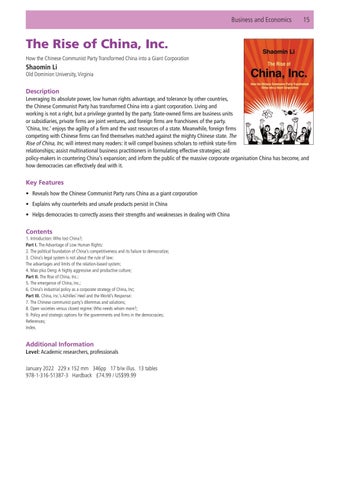Business and Economics
15
The Rise of China, Inc. How the Chinese Communist Party Transformed China into a Giant Corporation
Shaomin Li
Old Dominion University, Virginia
Description Leveraging its absolute power, low human rights advantage, and tolerance by other countries, the Chinese Communist Party has transformed China into a giant corporation. Living and working is not a right, but a privilege granted by the party. State-owned firms are business units or subsidiaries, private firms are joint ventures, and foreign firms are franchisees of the party. ‘China, Inc.’ enjoys the agility of a firm and the vast resources of a state. Meanwhile, foreign firms competing with Chinese firms can find themselves matched against the mighty Chinese state. The Rise of China, Inc. will interest many readers: it will compel business scholars to rethink state-firm relationships; assist multinational business practitioners in formulating effective strategies; aid policy-makers in countering China’s expansion; and inform the public of the massive corporate organisation China has become, and how democracies can effectively deal with it.
Key Features • Reveals how the Chinese Communist Party runs China as a giant corporation • Explains why counterfeits and unsafe products persist in China • Helps democracies to correctly assess their strengths and weaknesses in dealing with China
Contents 1. Introduction: Who lost China?; Part I. The Advantage of Low Human Rights: 2. The political foundation of China’s competitiveness and its failure to democratize; 3. China’s legal system is not about the rule of law: The advantages and limits of the relation-based system; 4. Mao plus Deng: A highly aggressive and productive culture; Part II. The Rise of China, Inc.: 5. The emergence of China, inc.; 6. China’s industrial policy as a corporate strategy of China, Inc; Part III. China, inc.’s Achilles’ Heel and the World’s Response: 7. The Chinese communist party’s dilemmas and solutions; 8. Open societies versus closed regime: Who needs whom more?; 9. Policy and strategic options for the governments and firms in the democracies; References; Index.
Additional Information Level: Academic researchers, professionals January 2022 229 x 152 mm 346pp 17 b/w illus. 13 tables 978-1-316-51387-3 Hardback £74.99 / US$99.99



